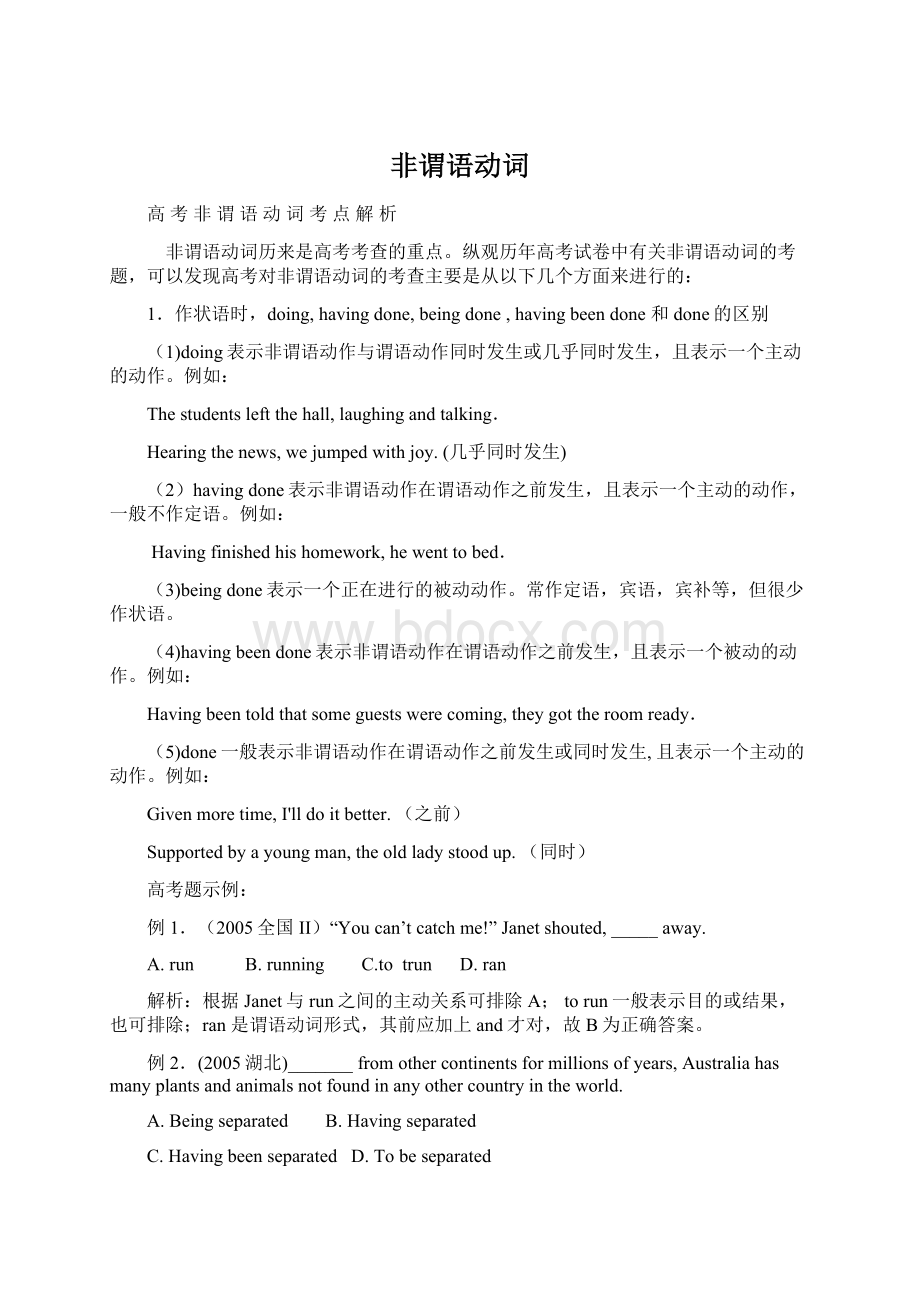 非谓语动词.docx
非谓语动词.docx
- 文档编号:3574138
- 上传时间:2022-11-24
- 格式:DOCX
- 页数:14
- 大小:23.64KB
非谓语动词.docx
《非谓语动词.docx》由会员分享,可在线阅读,更多相关《非谓语动词.docx(14页珍藏版)》请在冰豆网上搜索。

非谓语动词
高 考 非 谓 语 动 词 考 点 解 析
非谓语动词历来是高考考查的重点。
纵观历年高考试卷中有关非谓语动词的考题,可以发现高考对非谓语动词的考查主要是从以下几个方面来进行的:
1.作状语时,doing,havingdone,beingdone,havingbeendone和done的区别
(1)doing表示非谓语动作与谓语动作同时发生或几乎同时发生,且表示一个主动的动作。
例如:
Thestudentsleftthehall,laughingandtalking.
Hearingthenews,wejumpedwithjoy.(几乎同时发生)
(2)havingdone表示非谓语动作在谓语动作之前发生,且表示一个主动的动作,一般不作定语。
例如:
Havingfinishedhishomework,hewenttobed.
(3)beingdone表示一个正在进行的被动动作。
常作定语,宾语,宾补等,但很少作状语。
(4)havingbeendone表示非谓语动作在谓语动作之前发生,且表示一个被动的动作。
例如:
Havingbeentoldthatsomeguestswerecoming,theygottheroomready.
(5)done一般表示非谓语动作在谓语动作之前发生或同时发生,且表示一个主动的动作。
例如:
Givenmoretime,I'lldoitbetter.(之前)
Supportedbyayoungman,theoldladystoodup.(同时)
高考题示例:
例1.(2005全国II)“Youcan’tcatchme!
”Janetshouted,_____away.
A.run B.running C.to trun D.ran
解析:
根据Janet与run之间的主动关系可排除A;torun一般表示目的或结果,也可排除;ran是谓语动词形式,其前应加上and才对,故B为正确答案。
例2.(2005湖北)_______fromothercontinentsformillionsofyears,Australiahasmanyplantsandanimalsnotfoundinanyothercountryintheworld.
A.Beingseparated B.Havingseparated
C.Havingbeenseparated D.Tobeseparated
解析:
根据Australia与separate之间的被动关系可排除B;A表示“正在被分开”,故答案是C,表示该被动动作发生在谓语动作has之前。
例3.(2005上海)_______intouseinApril2000,thehotlinewasmeantforresidentsreportingwaterandheatingsupplybreakdowns.
A.Put B.Putting C.Havingput D.Beingput
解析:
根据hotline与put…intouse之间的被动关系可排除B和C;D表示“正在被使用”,这与inApril2000是矛盾的,故A为正确答案,put是过去分词形式。
2.作定语时,done,beingdone和tobedone的区别
先看例句:
Thisisaproblemdiscussed.这是一个已经讨论了的问题。
(已经完成的被动动作)
Thisisaproblembeingdiscussed.这是一个正在讨论的问题。
(正在进行的被动动作)
Thisisaproblemtobediscussed.这是一个将要讨论的问题。
(将要进行的被动动作)
高考题示例:
例:
(2004浙江)LindaworkedfortheMinnesotaManufacturingandMiningCompany,_____as3M.
A.knowing B.known C.beingknown D.tobeknown
解析:
knowing表示主动首先排除A;beingknown表示“正在出名”;tobeknown表示将要出名;known表示已经出名,故B正确。
3.作感官动词的宾补doing,(to)do和done的区别
Didyouhearanyonesinginginthenextroom?
你听到有人在隔壁唱歌吗?
(主动、正在进行)
DidyoueverhearanyonesingthesonginEnglish?
你曾听过有人用英语唱过这首歌吗?
(主动、已经完成或动作的全过程)
DidyouhearthesongsunginEnglish?
你听过这首歌用英语唱过吗?
(被动、已经完成)
高考题示例:
例:
(NMET1994)Themissingboyswerelastseen____neartheriver.
A.playing B.tobeplaying C.play D.toplay
解析:
由于题干是被动语态,所以首先排除C;A表示正在进行的动作,符合语境werelastseen的要求;D表示全过程,这不合逻辑;此题相当易错选B,但是tobedoing不可能作感官动词的宾补或主语补足语,故A为正确答案。
4.作宾语时,doing与todo的区别
(1)只能用-ing形式作宾语的动词常用的有:
dislike/delay/deny,mind/miss(错过),enjoy/escape(逃避)/excuse,practise/pardon/permit,suggest/stop/stand(忍受),consider,keep,advise/admit/acknowledge(承认)/allow/appreciate(欣赏、感激)/avoid(避免),risk(冒险)/resist(抵制)/recommend(建议);finish/forbid,imagine。
为了巧记这些动词,取他们的首字母拼成dmepsckarfi(谐音为“弟妹不吃咖啡”)
(2)只能用todo作宾语的动词有:
afford,agree,aim,choose,dare,decide,decline(拒绝),refuse,desire,determine,fail,offer,expect,hope,wish,manage,plan,pretend,promise,seek,tend,threaten等。
(3)既能用-ing形式又能用todo作宾语的动词分两种情况:
1)象like,love,prefer,hate;begin,start;continue;intend,attempt(试图),bear(忍受)等词用-ing形式和todo作宾语时意义相同。
例如:
Hestartedlearning/tolearnEnglishattheageofthree.
2)意义不同的动词有:
①remember/forget
②regret
③try
④mean
⑤goon
⑥want/need/require
高考题示例:
例:
(2005北京)Whenaskedbythepolice,hesaidthatheremembered______attheparty,butnot_______.
A.toarrive;leaving B.toarrive;toleave
C.arriving;leaving D.arriving;toleave
解析:
remembernotleaving意思是“记得没有离开过”,remembernottoleave意思是“记住不去做某事”;而整个题干的意思是“当被警方询问时,他说他记得参加了舞会,但是不曾离开过”。
故C正确。
5.-ing形式作伴随状语与不定式作目的状语的区别
作伴随状语的-ing形式与谓语动词的动作同时发生且前面常常带一逗号;而作目的状语的不定式的动作要比谓语动词的动作后发生前面不能用逗号。
例如:
Shewrotetotheeditor,hopingthattheeditorwouldbeabletohelpher.
Shereachedthetopofthehillandstoppedtheretorestonabigrock.
高考题示例:
例:
(1991全国)Thesecretaryworkedlateintonight,___alongspeech.
A.toprepare B.preparing C.prepared D.waspreparing
解析:
首先从逗号可以排除D;又由于thesecretary与prepare是主动关系来排除C;再根据非谓语动词prepare的动作和谓语动词work同时发生,而不是后发生,所以选B。
6.-ing形式和不定式作结果状语的区别
-ing形式作结果状语表示一定逻辑的结果,即结果在意料之中,其作用相当于一个非限制性的定语从句;而不定式作结果状语通常表示非逻辑的结果,即结果在意料之外。
例如:
Anumberofnewmachineswereinstalledinthefactory,thusresultinginanincreaseinproduction.=…,whichthusresultedinanincreaseIproduction.
Hehurriedlyfinishedhisbreakfastandwentrunningtothestation,onlytofindthetrainhadlefthalfanhourbefore.
高考题示例:
例1(2005山东)Oilpriceshaverisenby32percentsincethestartoftheyear,_____arecordUS$57.65abarrelonApril4.
A.havereached B.reaching C.toreach D.tobereaching
解析:
A是谓语动词可以首先排除;D一般不作状语也可排除;B作结果状语表示一定逻辑的结果,正合题意;C作目的状语时往往指意外的结果,故正确答案是B。
例2.(2004福建)Thenewsreportershurriedtotheairport,only______thefilmstarshadleft.
A.totell B.tobetold C.telling D.told
解析:
首先根据Thenewsreporters和tell的被动关系排除A和C;不定式一般表示一个出乎意外的结果,tobetold符合语境,故B正确;而过去分词一般不作这样的结果状语。
7.非谓语动词的否定式
-ing形式否定式由“not/never+-ing”构成,不定式的否定式由“not/nevertodo”构成。
例如:
Imustapologizefornotlettingyouknowaheadoftime.
Nothavingdonetheworkwell,wedecidedtotryagain.
Thepatientwaswarnednottoeatoilyfoodaftertheoperation.
高考题示例:
例:
(2004广东)_____theprogramme,theyhavetostaythereforanothertwoweeks.
A.Notcompleting B.Notcompleted
C.Nothavingcompleted D.Havingnotcompleted
解析:
本题考查—ing的否定式。
首先根据complete与havetostay的动作先后确定–ing用完成式,再根据-ing的否定式可确定正确答案是C。
8.非谓语动词的复合结构
(1)不定式的复合结构:
由“for/ofsbtodo” 构成,在句中一般作主语和宾语。
例如:
Itisnecessaryforustostartatonce.
Itwascruelofhimtobeatthepoorchild.
(2)动名词的复合结构:
(以Tom为例)
由“Tom’sdoing”或“hisdoing”构成,在句中一般作主语和宾语。
Tom’sbeingillmadehismotherworried.
Yourcomingherewillhelpusalot.
作宾语时,也可以用“Tomdoing”或“himdoing”形式
Heinsistedonhisson’s/songoingontocollege.
Wouldyoumindmy/meopeningthewindow?
(3)含不定式或分词的独立主格结构:
由介词“with+宾语+todo/doing/done”构成在句中一般作定语和状语。
Hesatunderthetreewithhiseyeslookingupwardandhisfingerscrossed.
Withsomanyeyesfixeduponher,thegirlwastoonervoustosayanything.
Withalotofdifficultproblemstosettle,thenewly-electedpresidentishavingahardtime.
注意:
介词有时可以省略。
例如:
We’llsurelygetthefirstprizewithyoutojoinustomorrow.
Thedriverseeingatreelyingacrosstheroadahead,thebuswasstopped.
Itbeingafineday,theywentoutforawalk.
高考题示例:
例1.(2002上海春)Withalotofdifficultproblems______,thenewly-electedpresidentishavingahardtime.
A.settled B.settling C.tosettle D.beingsettled
解析:
本题考查独立主格结构,难度极大。
A项的settled表示“问题已经被解决了“,这与下文的ishavingahardtime相矛盾;D项的besettling表示“问题正在被解决”与下文也是矛盾的;而tosettle的意思是“将要解决”,用主动形式表示被动意义,因为settle的动作执行者在句中出现,故答案是C。
例2.(2005安徽)Ireallycan’tunderstand____herlikethat.
A.youtreat ` B.youtotreat
C.whytreat D.youtreating
解析:
understand的用法是接-ing作宾语没有接不定式做宾补的用法,故排除B;youtreating是动名词的复合结构,当然也可以用yourtreating形式,故D正确。
高考英语非谓语动词(四)
七、考查“with+复合宾语”中的非谓语区别
e.g.Themurderwasbroughtin,withhishands____behindhisback.
A.beingtired B.havingtired C.tobetired D.tied
A项表示现在正在被绑,无B项这样的结构,C项表示将来被绑。
从wasbroughtin判断,tied的动作发生在过去的动作broughtin之前,hishands和tied之间又是被动关系,故正确答案为D。
学习要点
todo:
todo动作发生于将来,与宾语是主动关系。
如果与宾语是被动关系则用tobedone。
with+宾语+非谓语doing:
doing动作正在进行,与宾语是主动关系。
如果与宾语是被动关系则用beingdone。
done:
done动作已完成,即结束在过去,与宾语是被动关系。
e.g.Withnightfalling,wehurriedhome.
falling与宾语night是主动关系,falling与hurried两个动作几乎同时发生。
e.g.Withthefinalexamtobeheldnextweek,thestudentsarebusyreviewingtheirlessons.
宾语thefinalexam与hold是被动关系,tobeheld动作发生于将来nextweek。
八、考查非谓语动词的时态和语态
1.Robertissaid____abroad,butIdon'tknowwhatcountryhestudiedin.(NMET'99)
A.tohavestudied B.tostudy C.made D.tomake
2、Heclaimed____inthesupermarketwhenhewasdoingshoppingyesterday.(上海'98)
A.beingbadlytreated B.treatingbadly
C.tobetreatedbadly D.tohavebeenbadlytreated
3.Iwouldlove____tothepartylastnightbutIhadtoworkextrahourstofinishareport.(NMET'97)
A.togo B.tohavegone C.going D.havinggone
4.ThevisitingMinisterexpressedhissatisfactionwiththetalks,____thathehadenjoyedhisstayhere.(NMET'94)
A.havingadded B.toadd C.adding D.added
5.LittleJimshouldlove____tothetheatrethisevening.
A.tobetaken B.totake
C.beingtaken D.taking
6.Hehasalwaysinsistedonhis____Dr.TurnerinsteadofMr.Turner.(上海'92)
A.beencalled B.called
C.havingcalled D.beingcalled
分析
1.不定式to所表示的动作发生在谓语动词said所表示的动作之前,故正确答案A。
2.he和treat之间是被动关系,A项表示treat和claim同时发生,C项表示treat在claim之后发生,根据句义treat的动作发生在claim之前,故正确答案D。
3.B。
should(would)like(love)后必须跟不定式todosth.,A表示动作尚未发生,但从lastnight判断,动作应发生在过去。
4.C。
adding=andadded,adding与expressed同步进行,所以不用A,它们之间不是被动关系,所以不用D。
5.should(would)like(love)后必须跟不定式todosth.,而littleJim和take之间是被动关系,故正确答案A。
6.insiston之后必须跟动名词doing,而he和call之间是被动关系,故正确答案D。
hisbeingcalled构成动名词复和结构。
学习要点
只要弄清非谓语和它的逻辑主语之间是主动关系还是被动关系,以及非谓语所发出的动作与句子的谓语所发出的动作的先后关系就可以了。
九、考查非谓语动词的否定结构
1.Tonywasveryunhappyfor____totheparty.(上海2000)
A.havingnotbeeninvited B.nothavinginvited
C.havingnotinvited D.nothavingbeeninvited
2.Whatworriedthechildmostwas____tovisithismotherinthehospital.(上海'98)
A.hisnotallowing B.hisnotbeingallowed
C.hisbeingnotallowed D.havingnotbeenallowed
3.Thepatientwaswarned____onlyfoodaftertheoperation.(NMET'96)
A.toeatnot B.eatingnot
C.nottoeat
- 配套讲稿:
如PPT文件的首页显示word图标,表示该PPT已包含配套word讲稿。双击word图标可打开word文档。
- 特殊限制:
部分文档作品中含有的国旗、国徽等图片,仅作为作品整体效果示例展示,禁止商用。设计者仅对作品中独创性部分享有著作权。
- 关 键 词:
- 谓语 动词
 冰豆网所有资源均是用户自行上传分享,仅供网友学习交流,未经上传用户书面授权,请勿作他用。
冰豆网所有资源均是用户自行上传分享,仅供网友学习交流,未经上传用户书面授权,请勿作他用。


 如何打造酒店企业文化2刘田江doc.docx
如何打造酒店企业文化2刘田江doc.docx
